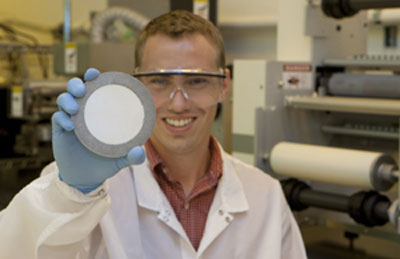One step closer to rollable, foldable electronic devices
(Nanowerk News) The next generation of electronic displays – e-Readers, smartphones and tablets – is closer thanks to research out today from the University of Cincinnati.Advances that will eventually bring foldable/rollable e-devices as well as no pixel borders are experimentally verified and proven to work in concept at UC’s Novel Devices Laboratory. That research is published this week in the journal Nature Communications.The e-Sheet, a virtually indestructible e-device, will be as thin and as rollable as a rubber mat. UC research is bringing closer the e-Sheet, shown here in a photo illustration. e-Devices will one day be as thin and as rollable as a rubber mat.The UC paper, “Bright e-Paper by Transport of Ink through a White Electrofluidic Imaging Film” is authored by College of Engineering and Applied Science doctoral students Matthew Hagedon, Shu Yang, and Ann Russell, as well as Jason Heikenfeld, associate professor of electronic and computing systems. UC worked on this research with partner: start-up company Gamma Dynamics.

Matthew Hagedon with electrofluidic imaging film. The white, plastic film, ten times thinner than a sheet of paper, is in a rigid frame for support during lamination into a display. The goal is a large roll of film that can be laminated onto electronics.
One challenge in creating foldable e-Paper devices has been the device screen, which is currently made of rigid glass. But what if the screen were a paper-thin plastic that rolled like a window shade? You’d have a device like an iPad that could be folded or rolled up repeatedly – even tens of thousands of time. Just roll it up and stick it in your pocket.The UC research out today experimentally verifies that such a screen of paper-thin plastic, what the researchers refer to as “electrofluidic imaging film,” works. The breakthrough is a white, porous film coated with a thin layer of reflective electrodes and spacers that are then subjected to unique and sophisticated fluid mechanics in order to electrically transport the colored ink and clear-oil fluids that comprise the consumer content (text, images, video) of electronic devices.According to UC’s Hagedon, “This is the first of any type of electrowetting display that can be made as a simple film that you laminate onto a sheet of controlling electronics. Manufacturers prefer this approach compared to having to build up the pixels themselves within their devices, layer by layer, material by material. Our proof-of-concept breakthrough takes us one step closer to brighter, color-video e-Paper and the Holy Grail of rollable/foldable displays.”
No comments:
Post a Comment